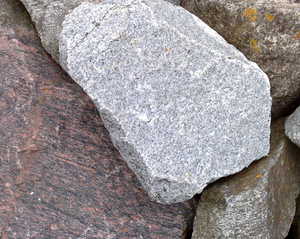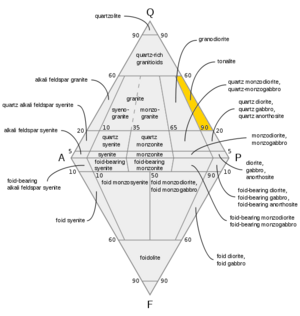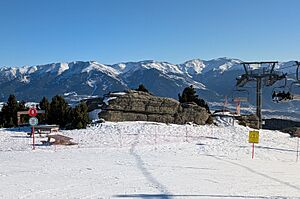Tonalite facts for kids

Tonalite is a type of rock that forms deep underground when molten rock (magma) cools and solidifies. Geologists call this an "intrusive" or "plutonic" igneous rock. It's usually light-colored and has large mineral grains that you can easily see, which means it has a "coarse-grained" or "phaneritic" texture.
Tonalite is considered a "felsic" rock, meaning it's rich in lighter-colored minerals like feldspar and quartz, and has less of the darker, heavier minerals.
Contents
What is Tonalite Made Of?
The main minerals you'll find in tonalite are:
- Plagioclase Feldspar: This is the most common type of feldspar in tonalite. It's often a variety called oligoclase or andesine.
- Alkali Feldspar: Tonalite has very little of this type of feldspar – less than 10% of all the feldspar in the rock.
- Quartz: This mineral makes up a significant part of tonalite, more than 20% of its total quartz, alkali feldspar, plagioclase, and feldspathoid content. This is a key feature that helps geologists identify tonalite.
You might also find smaller amounts of darker minerals like amphiboles and biotite. Other tiny "accessory" minerals that can be present include apatite, magnetite, and zircon.
How is Tonalite Different from Other Rocks?
Sometimes, in older geology books, you might see tonalite used to mean the same thing as quartz diorite. However, today's official classification system, used by the IUGS (International Union of Geological Sciences), makes a clear difference between them.
The main difference is the amount of quartz:
- Tonalite must have more than 20% quartz.
- Quartz diorite has less quartz, ranging from 5% to 20%.
Geologists use a special chart called the QAPF diagram to classify these rocks based on their mineral content.
Where Does the Name Tonalite Come From?
The name Tonalite comes from the place where this rock was first studied and described. This place is near the Tonale Line, which is a major geological feature and a mountain pass called Tonale Pass. This pass is located in the Italian and Austrian Alps.
The term was first used by a geologist named Gerhard vom Rath in 1864.
What About Adamellite?
Another term you might come across in older texts is adamellite. This name was first used in 1890 by A. Cathrein for a rock found at Monte Adamello in Italy, which was a type of tonalite that also contained orthoclase (a type of alkali feldspar). However, the term adamellite later became confusingly used for a different rock called quartz monzonite. Because of this confusion, adamellite is now a "deprecated term," meaning geologists no longer use it in official classifications.
What is Trondhjemite?
Trondhjemite is a special type of tonalite. It's named after Trondheim, Norway's third-largest city. What makes Trondhjemite unique is that it:
- Doesn't have much orthoclase feldspar.
- Is rich in sodium.
- Has very little of the dark mineral biotite, and often no other dark minerals at all.
Where Can You Find Tonalite?
Tonalites, along with similar rocks like granodiorites, are commonly found in huge bodies of rock called batholiths. These batholiths often form in areas where Earth's tectonic plates are crashing into each other, specifically above subduction zones. A subduction zone is where one tectonic plate slides underneath another, leading to melting and the formation of magma that then cools to create rocks like tonalite.



